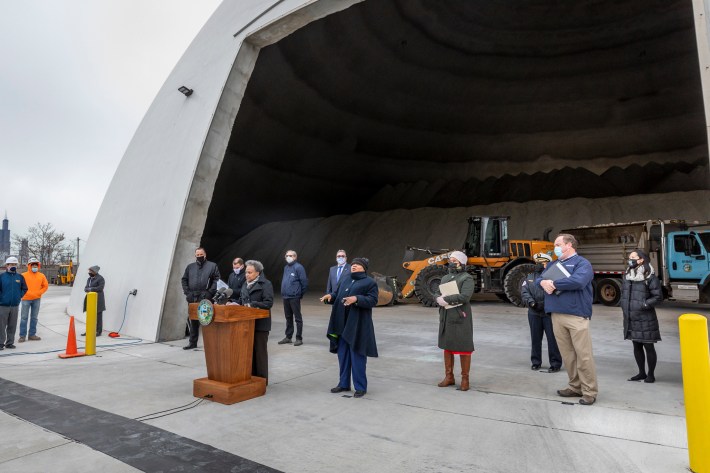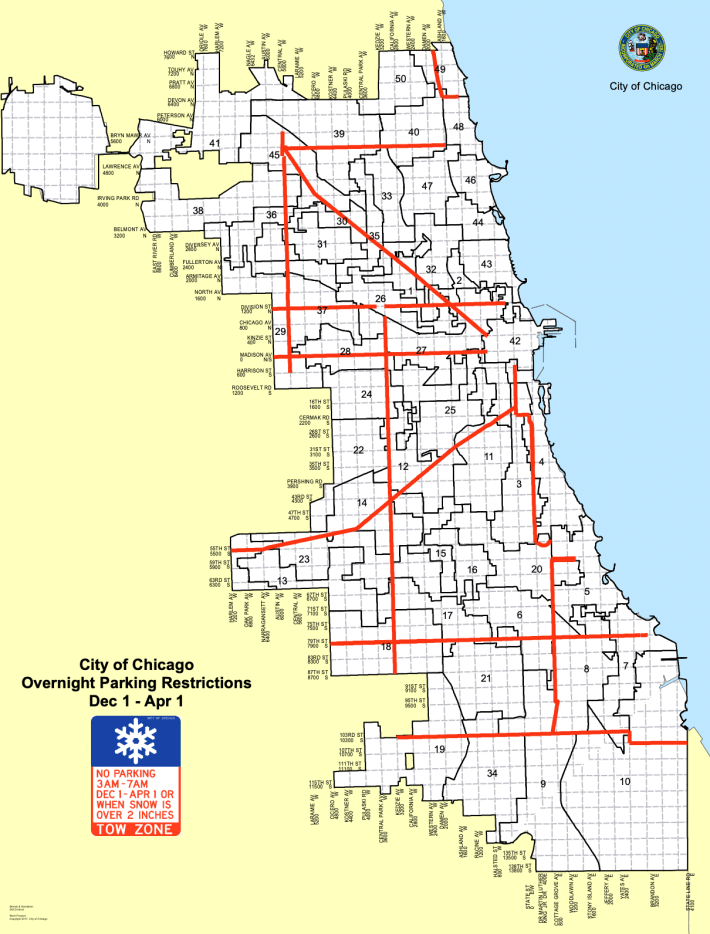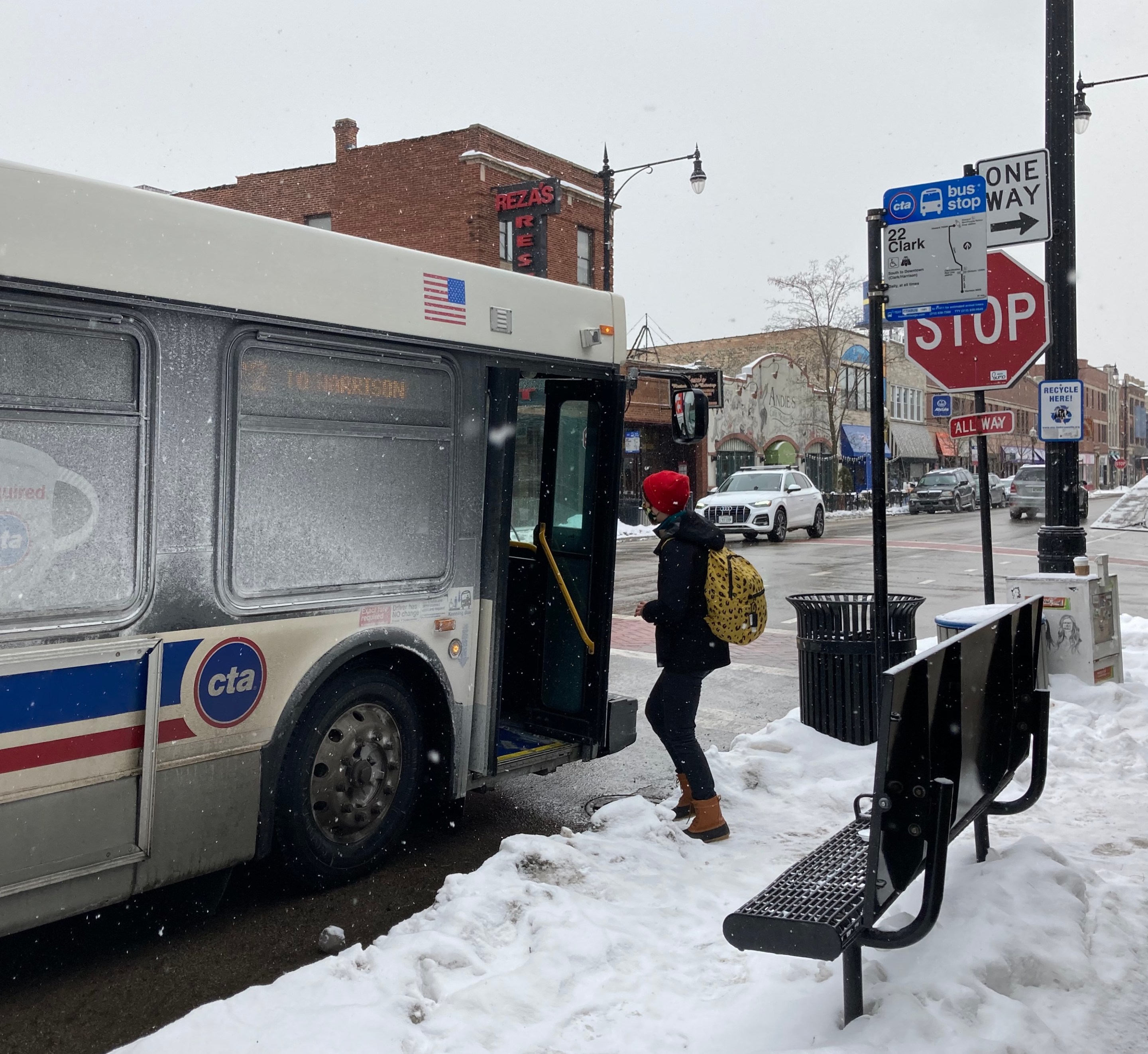Back in 1979, Chicago mayor Michael Bilandic failed to adequately respond to a historic blizzard, and lost reelection as a result. Thanks to him, city officials are fairly obsessed with keeping the local transportation system functional during extreme weather – for drivers, at least.
Earlier this week Mayor Lori Lightfoot and various department heads gathered at Chicago's newest road salt storage dome, 2555 W. Grand Ave., to announce what various departments will be doing to keep residents safe and mobile during bitterly cold temperatures and heavy snowfalls this winter. First let's look at the city's planned surface transportation-related strategies. And then I'll discuss what Chicagoans who primarily walk, bike, and ride transit would like to see the city do differently this year.

"Just like we are each year, the city is fully prepared to manage winter operations and work together to provide the critical services our residents need to stay safe and warm," said Lightfoot in a statement. "Throughout the planning process, we've made sure city departments and agencies are well-equipped with the tools they need to fulfill this responsibility, including the new salt dome which will help make our streets safe and accessible during inclement weather."
Here's what some of the departments have planned, as it relates to winter mobility.
Office of Emergency Management and Communications
OEMC coordinates the city's winter weather emergency responses, and held a winter weather workshop in October with public safety and infrastructure departments, sister agencies and other partners to pregame for the season.
OEMC will make announcements when thresholds set by the National Weather Service are reached these are (in the city's words):
- Winter Weather Advisory: Potentially dangerous winter weather is expected within the next 12-36 hours; Travel difficulties expected.
- Winter Storm Warning: Dangerous winter weather is expected in the next 12-36 hours or is occurring; Travel problems are expected.
- Blizzard Warning: Severe winter weather is expected in the next 12-36 hours or is occurring – including white out conditions. Do not travel.
Here's how to get weather-related notifications.
- Notify Chicago: Sign up for emergency alerts at www.NotifyChicago.org
- CHILAKE: For lakefront notices including flooding, TEXT “CHILAKE” to 7-8-0-1-5
Department of Streets and Sanitation
According to the city, Streets and San has a fleet of more than 300 snow vehicles, including 20 new salt spreaders and four front-end loaders. The department has 425,000 tons of salt stored at salt piles across the city. Officials say, "'Turn-By-Turn, DSS' state-of-the-art navigational software that provides turn-by-turn guidance to snowplow drivers, and tracks work completion in real time, is now fully implemented across all city routes for the first time this year." View the city's Plow Tracker here.
Chicago's annual winter Overnight Parking Ban begins this evening, December 1, and will be enforced through April 1, 2022, daily from 3:00 a.m. to 7:00 a.m., whether or not there's snow. The Overnight Parking Ban includes about 107 miles of streets. According to the city, when drivers don't obey the parking ban, it prevents key arterial streets from being fully plowed and salted, and ice and snow accumulating next to the vehicles reduces traffic flow. Violators of the ban face a minimum $150 towing fee, a $60 ticket, and a storage fee of $25 per day.

What we'd like to see happen
While the city is diligent about plowing main streets for drivers (and, in fairness, bus riders), maintenance of pedestrian infrastructure is spotty. While the Chicago Department of Transportation is theoretically responsible for keeping pedestrian islands and bridge sidewalks clear, in practice this infrastructure is often snow-clogged. Lack of snow clearance is also often a barrier for CTA bus stops and bus shelters.
And, of course, when it comes to sidewalks in front of privately-owned homes or retail buildings, property owners and residents are responsible for snow-clearance, and tickets for non-compliance appear to be fairly rare. The resulting uncleared walkways are a serious barrier to mobility for wheelchair users, seniors, and families with small children.
I want them to plow the damn sidewalks.
— Molly Fleck (@mollyfleck) December 1, 2021
The local sustainable transportation advocacy group Better Streets Chicago called on City Hall to adopt a plan for city staff to take responsibility for all sidewalk snow clearance with a petition that has garnered more than 2,200 signatures (sign here) and a social media campaign following last February’s unusually high snowfall – over 20 inches in a month. "As it stands, the city unfairly prioritizes plowing the roads for drivers as a public good that must be funded with taxpayer dollars, whereas clearing the sidewalks for pedestrians is an unfunded, spottily-enforced mandate," wrote Better Streets organizer Michael Podgers in a recent Streetsblog op-ed.
And then there are protected bike lanes, which do more harm than good for bike commuters if they're not plowed in a timely and effective manner after major snowfalls. While Streets and San plows mixed-traffic lanes, the Chicago Department of Transportation, which builds the bikeways, is generally responsible for clearing snow from them, using special smaller snowplows. While CDOT spokesperson Mike Claffey said in a 2018 interview the department's goal is to clear bike lanes within 24 hours of a snowfall, it appears that in practice this rarely happens. "Because the bike lanes require special equipment for removal, the process can take a little longer [than clearing travel lanes for drivers],” Claffey acknowledged.
As much as @ChicagoDOT and @chicagosmayor love to yap about the (lousy, paint) bike lanes, the city's snow removal plan doesn't appear to have the word "bicycle" in it. https://t.co/Q2O3p3TwoP
— Bikes 🚴♀️ Peace ✌ Love ❤ (@NWChiFiets) December 1, 2021
Further complicating matters is the fact that is that maintenance workers sometimes shovel snow from the sidewalk into curbside bike lanes, which is a violation of Chicago’s snow clearing ordinance. (Instead, sidewalk snow should be piled on the sidewalk near the curb, in the “street furniture zone,” with occasional clear spots left to make it easier for people to travel between parked cars and the sidewalk.)
“This is about resources,” said Active Transportation Alliance spokesperson Kyle Whitehead at the time about the discrepancy between immediate mixed-traffic lane plowing and delayed bikeway clearance. “City agencies need the money for staff and equipment to identify where snow is piling up and remove it quickly from bike lanes. There’s little dedicated funding for building and maintaining biking and walking facilities citywide, which is why we’re pushing for a Chicago Bike Walk Fund.” Although Mayor Lightfoot promised to earmark $20 million a year for walking and biking during the 2019 election, she still hasn't done that.





